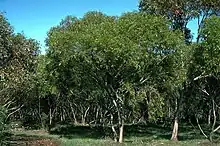| Ooragmandee | |
|---|---|
 | |
| Eucalyptus oraria south of Dongara | |
| Scientific classification | |
| Kingdom: | Plantae |
| Clade: | Tracheophytes |
| Clade: | Angiosperms |
| Clade: | Eudicots |
| Clade: | Rosids |
| Order: | Myrtales |
| Family: | Myrtaceae |
| Genus: | Eucalyptus |
| Species: | E. oraria |
| Binomial name | |
| Eucalyptus oraria | |
| Synonyms[1] | |
|
Eucalyptus tamala D.J.Carr & S.G.M.Carr | |
Eucalyptus oraria, commonly known as ooragmandee,[2] is a species of mallee that is endemic to coastal and near-coastal areas of Western Australia. It has smooth greyish bark, sometimes with rough, flaky bark on the base of the trunk, lance-shaped adult leaves, flower buds in groups of nine or more, white flowers and barrel-shaped fruit.
Description
Eucalyptus oraria is a mallee, rarely a tree or low shrub that typically grows to a height of 1–15 mm (0.039–0.591 in) and forms a lignotuber. It has smooth, greyish bark that is shed in strips, sometimes with rough, flaky bark on the base of the trunk. Young plants and coppice regrowth have dull green, egg-shaped to lance-shaped leaves that are 50–90 mm (2.0–3.5 in) long and 13–35 mm (0.51–1.38 in) wide. Adult leaves are the same shade of glossy green on both sides, lance-shaped, 65–100 mm (2.6–3.9 in) long and 8–23 mm (0.31–0.91 in) wide, tapering to a petiole 8–15 mm (0.31–0.59 in) long. The flower buds are arranged in leaf axils in groups of between nine and nineteen or more on an unbranched peduncle 5–15 mm (0.20–0.59 in) long, the individual buds on pedicels 1–3 mm (0.039–0.118 in) long. Mature buds are oval, 4–7 mm (0.16–0.28 in) long and 2–4 mm (0.079–0.157 in) wide with a rounded operculum. Flowering mainly occurs from August to October and the flowers are white. The fruit is a woody, barrel-shaped capsule with the valves below the level of the rim.[2][3][4]
Taxonomy and naming
Eucalyptus oraria was first formally described in 1962 by Lawrie Johnson from specimens he collected near Dongara in 1960. The specific epithet (oraria) is from the Latin orarius meaning "pertaining to the coast".[5]
Distribution and habitat
Ooragmandee grows in sand in coastal and near-coastal areas, often over limestone and is found from near Jurien Bay to near Kalbarri and on some nearby offshore islands.[2][3]
See also
References
- 1 2 "Eucalyptus oraria". Australian Plant Census. Retrieved 22 November 2019.
- 1 2 3 Chippendale, George M. "Eucalyptus oraria". Australian Biological Resources Study, Department of the Environment and Energy, Canberra. Retrieved 22 November 2019.
- 1 2 "Eucalyptus oraria". Euclid: Centre for Australian National Biodiversity Research. Retrieved 31 May 2020.
- ↑ "Eucalyptus oraria". FloraBase. Western Australian Government Department of Biodiversity, Conservation and Attractions.
- ↑ Francis Aubie Sharr (2019). Western Australian Plant Names and their Meanings. Kardinya, Western Australia: Four Gables Press. p. 266. ISBN 9780958034180.